

It took place on the brackish waters of Wells Cove in Southern Maryland, about an hour from Washington DC, a five RC schooner sort of `break the ice’ series of races run for members of the Great Schooner Model Society.
It is home waters for George and Marla Surgent who say that they have been fortunate to have lived on its banks for the past 34 years, and for more than ten of those years have hosted model schooner regattas, so much so that model sailing friends now fondly refer to it as `Surgent’s Cove’.
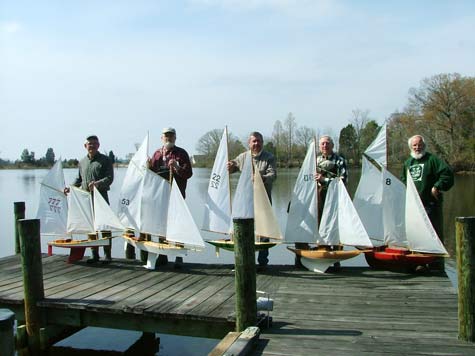
The Famous Five fleet
The cove is tidal and located at the mouth of aptly named `Battle Creek’ which empties into the Patuxent river which in turn flows into the Chesapeake Bay. Osprey, crabs, oysters and many fin fish, including some freshwater species call it home.
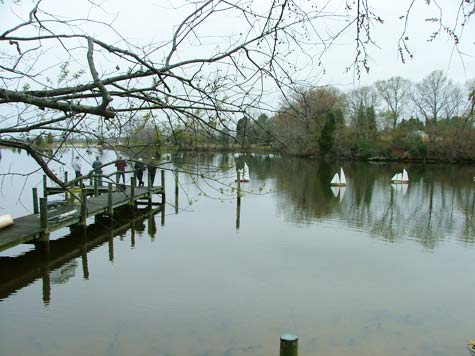
Where oysters and osprey and crabs and schooner men congregate!
So much for the venue, now for the skippers and their boats. First of all there was regatta host George (and wife, Marla) Surgent, he with his consistently successful sharpie schooner Bay Boy.
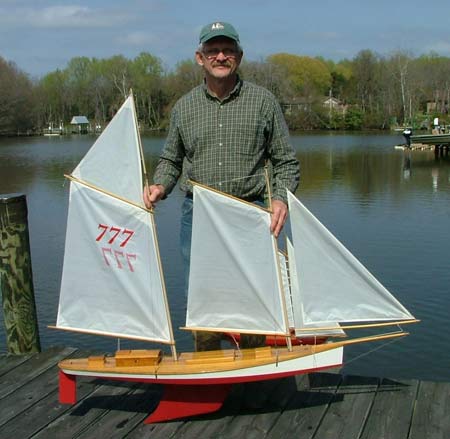
Regatta host, George Surgent with schooner Bay Boy
The sky was overcast and light winds prevailed until mid-afternoon when the sun came out, the wind then picking up a little but still on the light side. Four races were held pre-lunch and eight after lunch and a meeting on Great Schooner Model Society matters.
Top honours overall went to Al Suydam of Maryland with Rob Dalton of Virginia finishing second, George Surgent, Herb Jones and Marty Hayes all from Maryland in that order in the final results.
Marla Surgent took some really top photos as seen here and the writer is deeply indebted to her for so doing, and for e-mailing them within a couple of days. That is indeed `service with a smile!’
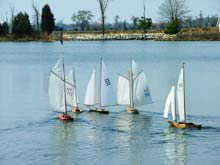
Downwind, Hanging out the Washing! |
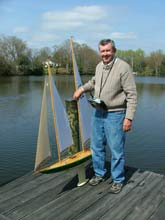
Al Suydam with winning boat |
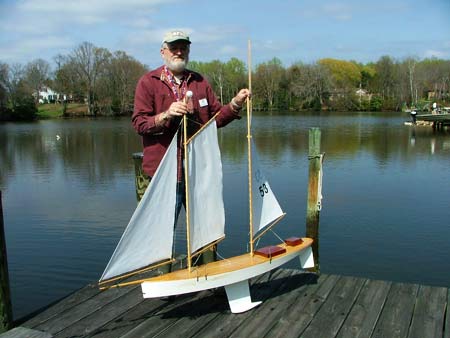
Rob Dutton with his sharpie schooner
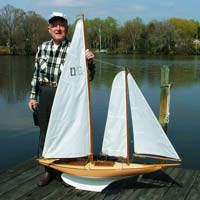
Herb Jones with his Chesapeake 5O schooner Miss Peg |
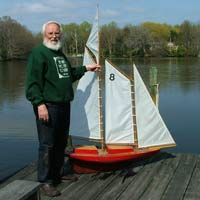
Marty Hayes with Vivian |

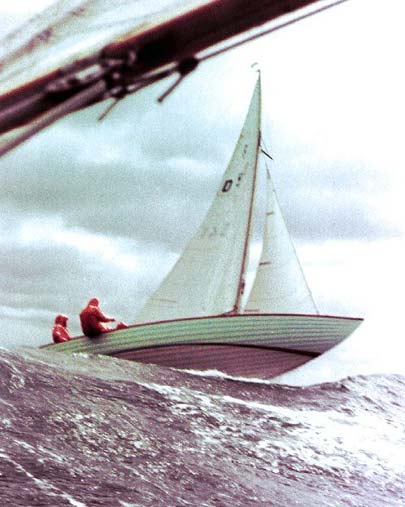
Eric Andreasen’s Folkboat Tibbe running from an impending storm in the Baltic sea
It is a photograph that literally `turns me on’ (even when I am not plugged in!) as some comedian once said!) and I make no apology for using it once again. It breathes of the open sea, a big Baltic sea getting bigger with developing giant swells as Eric Andreasen aboard his folkboat D541 Tibbe scuttles hastily for safety from an impending storm. The bow is out of the water and she is moving in great haste and nothing is going to stop her progress in force 9 to 10 winds on the Baltic sea.
The photo taken aboard his Folkboat D544 by Finn Hartvig is a wonderful shot that typifies what sailing is all about, the smell of the ocean, an element of danger, the wind and the spray in ones face, gathering clouds of warning and a decidedly pretty boat on full sail trying to beat a storm.

A decidedly different and much slower change in pace now, in fact it could be described as being a right royal `whoop-dee-do’ descent to a whole new level of ship modeling style and activity.
Welcome to the commercial world of a 35’ fishing dory based on one built 1970 in Whitianga, New Zealand. This is the `Dora Starr pictured in the photograph (below) tied up in Greymouth after a rough days sail She appears to have had a hard working life facing many a rough sea and extreme Winter storm conditions off the West Coast of the South Island of New Zealand.
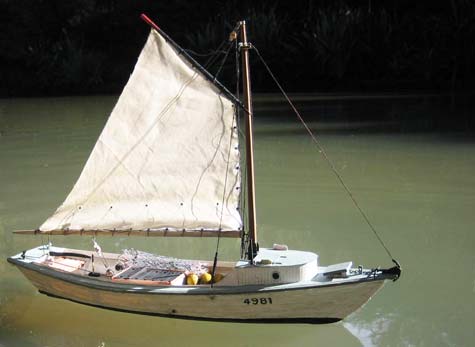
Going downstream on a post-storm test run
Woe is the life of a Dory fisherman but it is not really as bad as it looks for the `story’ is just that, a story of the`porky’ kind in order to set the scene on the build of a model just 17” long, (the Dora Starr 2481) built for the writer by my friend, talented modelmaker Harry Duncan, who created the fearsome looking brig the Black Rose which some may have read about in the November 2010 issue of Marine Modelling International.
Harry also photographed the mainly cardboard (the hull fibreglassed) model of the 32’ Dora Starr and his skill at `fabricating to order’ coupled with his object photography abilities suggests to me that he would be a very useful individual to someone like filmmaker Sir Peter Jackson.
This is a 1/24th scale model of the `weathered’ kind, a display model just 16” long built for a purpose, a model of a working ship not glossy and full of concourse d’elegance, not a single blemish in the paintwork beauty, instead presented in its utterly believable `used’ and post-storm battered guise.
The type of boat decided upon, Harry drew up the plans using a 2D cad programme, the plan being to use whatever he had in his workshop and not to buy anything. The hull and cabin were done from white card usually available from stationers, the keel a piece of 5mm balsa, the rubbing strake of strip balsa. The hull was waterproofed with Polyurethane wood glue, the deck planked with balsa strip, the rear helmsman seat and and fish hold added.
The mast is a wooden chopstick, the boom two takeway bamboo ones spliced together. Then came the detailing, a yellow 44 gallon drum of fuel, nets, cray pots and general clutter added, the sail hanging up to dry laced onto the boom and gaff, the rigging thread from a craft shop dyed when making the Black Rose brig, port and starboard lights added.
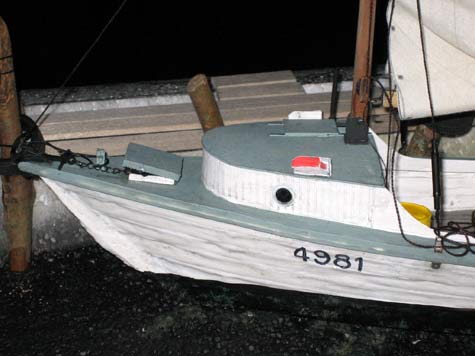
The West coast waters can be very turbulent and she had survived several inward crossings of the notoriously treacherous Greymouth bar, on the latest occasion seeking shelter from an afternoon storm with fierce gales on the coast she had only barely made it. She had come in on a very big sea some seventy meters astern of the fishing trawler, Valiant also having difficulties. With her engine getting low on diesel and with her bow one minute diving downwards, the next pointing towards the sky, and disappearing in deep troughs while skewing from side to side, she was taking in water over her bulwarks and the fear of her broaching was ever present to owner skipper Marvin Starr and his deck hand `Poochie' Green.
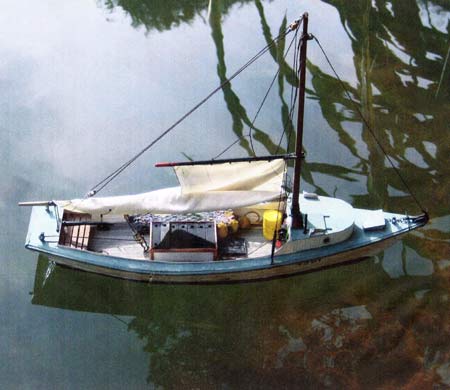

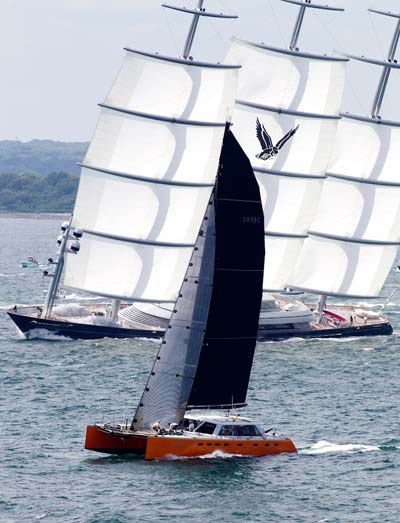
Photo Richard Langdon |
The Gunboat 66 Phaedo in the foreground, with the Perini Navi Maltese Falcon beyond it at their start of the 2011 Transatlantic Yacht Ract 2011 from Newport, Rhode Island in the USA to Lizard Point, South Cornwall photographed by Richard Langdon, UK British Sailing Photographer. Phaedo reached Cornwall ahead of the Maltese Falcon.
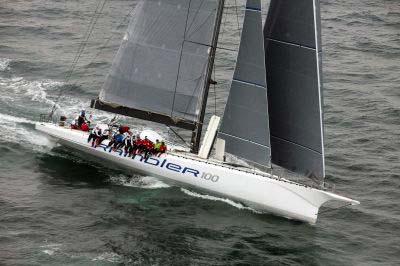
Photo Billy Black |
Line Houours winner was Rambler 100, George David's Maxi, photographed as the boat reached Lizard Point by photographer Billy Black. Their elapsed time was 6 days, 22 hours, 08 minutes, 2 seconds, a new record (still to be ratified) for the 2,975 nautical mile course.

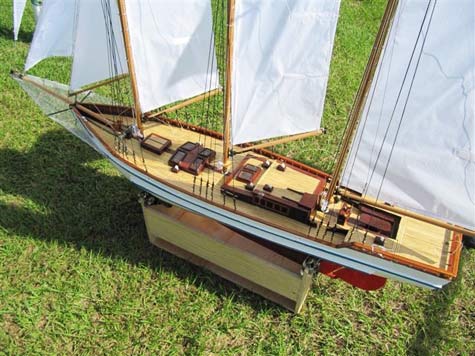
I have noticed an increase in the popularity of schooner models in Queensland, Australia, and I believe much of that is due to my mate, Rick Mayes in Maroochdore who has always been mad keen on schooners as sailing models, has built several and owns at least four.
His Lady Annette named after his first wife, inspired a friend of his, Bob Eldridge, to build his first
schooner seen above. Bob who has built some twenty models in his time lives near Melaney on the Sunshine Coast hinterland of Queensland.
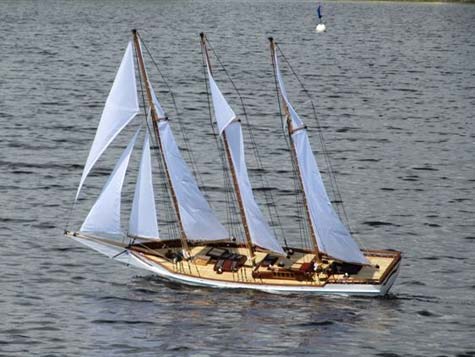
Carol Anne gathers momentum |
With Lady Annette (background) the two schooners cruise together |
His schooner built over six months on a hull the same as Rick’s 1700mm long Lady Annette has been built using mahogany for the cabins bulwarks and rails. Built a mite lighter than Rick’s schooner the Carol Anne is a pretty boat and a credit to his skills.

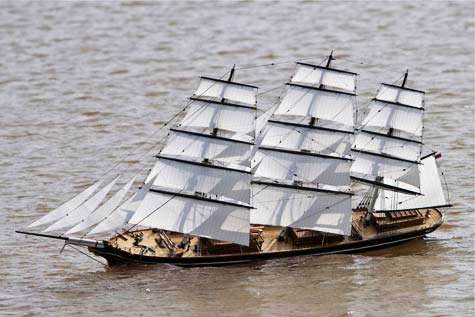
A new boat (above) from David Edwards of the UK’s Solent Radio Control Model Boat Club, (Some may remember I wrote about his fab model square-rigged ships in May then did a feature on the club in the June issue). It is of the 1854 launched Lightning, one of the last large clippers to be built in the USA. She was an extremely fast ship built for voyages to and from Australia. I remember reading somewhere, possibly in Wikepedia, that the ship was driven `rail under’ for long periods on many of these voyages.The model was photographed by Peter Taylor. The club’s website - use link
www.srcmbc.org.uk

-30- | 
